LEARNING
THE DO'S AND DONUTS
© 2011 Tor Pinney - All Rights Reserved
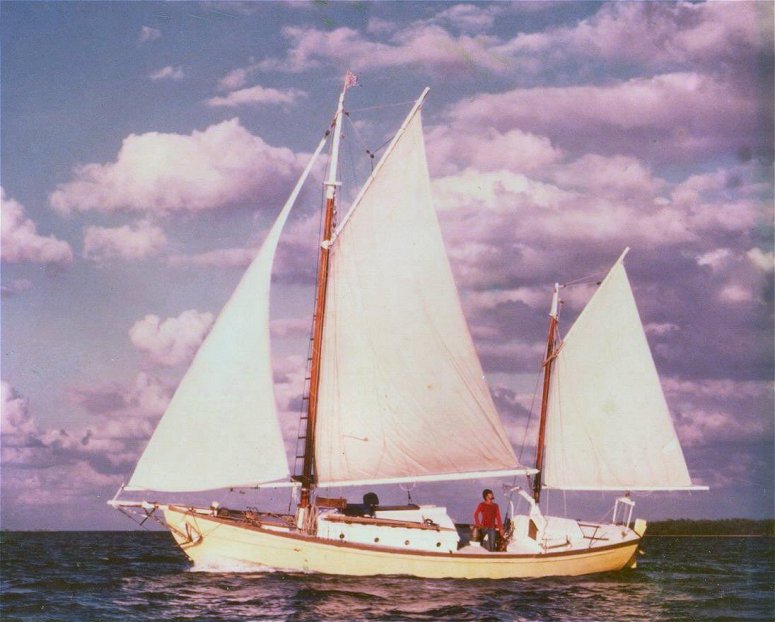
Four decades, five boats, and 150,000
nautical miles ago I bought the ketch “Autant.” Built in
1927, Autant was a William Hand designed classic with a
sweet sheer, 40-feet overall, double diagonal strip planked
and gaff rigged with a club-footed jib. She was a Spartan
vessel to be sure; no electrical system, no tankage, no
electronics, and no engine. I believe the polite term is
“traditional.” The youngest thing aboard was her skipper.
Nonetheless, that first day of my new command was, indeed,
one of the happiest days of my life, and the ketch Autant,
being mine, was the most beautiful sailboat I’d ever seen.
I procured a friendly tow down the
Miami River, where I’d bought the boat, to the outer
anchorage in Coconut Grove. Among Autant's gear was a great,
100-lb. navy-type anchor. I selected a likely spot amid the
fifty-odd anchored boats and shoved the massive hook
overboard, where it settled snugly into the soft sand
bottom. It would, I decided, be my mooring while I remained
in the
Miami
area.
|
The next morning I was up with the dawn,
anxious to take my new charge out for a sail. The day was
clear and favored us with a mild but steady breeze. My
girlfriend and I soon had all sails up and luffing at
anchor. We cast off the mooring line buoyed with a fish trap
float on a 6-foot pendant. Autant fell off, her sails
filled, and away we went.
|
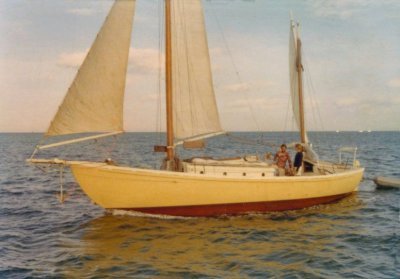 |
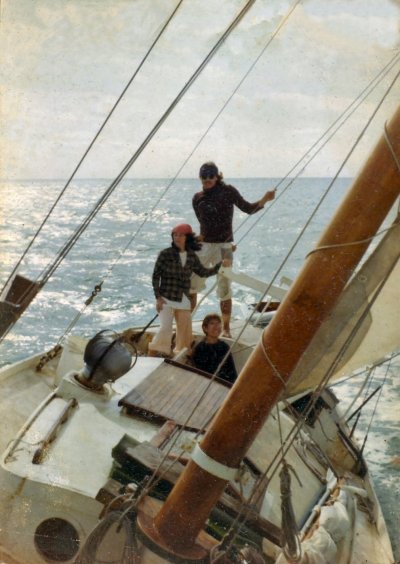 |
All that day we sailed on
Biscayne Bay, beating, reaching and running as we pleased.
The wind freshened a bit as I practiced maneuvers, learning
something of my new boat’s character - her strengths, limits
and idiosyncrasies – how she handled and tacked under
various sail combinations, how she carried when I rounded
up, and so on. Autant performed wonderfully!
Too soon it was time to head in, but I
smiled to think how impressive we'd look, sailing to our
mooring under the boat’s salty gaff-rig.
|
Into the crowded anchorage we flew,
carrying full sail in a 15-knot breeze, under the watchful
(and, I was certain, envious) eyes of a score of seasoned
liveaboard sailors. My classic old ketch wove smartly
through the other craft with a bone in her teeth, dodging
anchor rodes and tethered dinghies. We neared the critical
point to leeward of our mooring on a beam reach. My mate
stationed herself at the bow, boathook in hand.
Directly downwind of the little
Styrofoam ball, with all sails drawing I rounded up, Autant
moving at a fast clip. I was more concerned about
undershooting the mooring than overshooting it. Stopping
short of the mark would require us to fall off in tight
quarters or else risk drifting back in irons onto my nearest
neighbor to leeward.
The slatting sails set up an awful din,
drawing the attention of all within earshot. Autant slid
sleekly ahead. The buoy came under the bow and still she
carried forward. My girlfriend stabbed frantically at the
mooring pendant with the boathook as it slid past.
"Do you have it?"
"No!"
"Do you have it NOW?"
"No! Wait, uh, yes! I've got it!
I scurried to the foredeck to help. The
boat continued forward, dragging the mooring buoy alongside.
Hands clutched and tugged, the mooring line eye splice came
up, the boathook flipped overboard. Finally, with a
desperate heave, we secured the line onto the stem post. The
two of us leaned back and grinned at each other. "We did
it!"
But the fun wasn't over yet. All the
sails were still up and luffing and Autant was still making
way, the mooring line now streaming aft from the bow. Then
the line stiffened and the boat stopped short. Instantly the
bow became a pivot around which Autant swung broadside to
the wind. The sails filled.
In a moment we were broad reaching under
full sail around the anchor. A jibe was imminent. I fled to
the cockpit and hauled in on the mainsheet to ease the shock
on the rig. Just in time! WHAM! The sails slammed over and
the boat sailed on, the taut rode now pulling the bow around
to windward again. The sails luffed and we breathed a sigh
of relief.
But the next breath was a gasp of horror
as Autant once more coasted past the mooring, snubbed up on
the rode, and proceeded to repeat the entire sequence. Back
to the cockpit! Haul in the mainsheet! WHAM! What the hell
should I do now? The boat was already heading for her third
donut.
An old salt on a nearby schooner decided
he'd had enough entertainment for the afternoon. He cupped
his hands and yelled, "DROP YOUR JIB!"
The jib! It was an enlightening moment.
Autant was nearly hard up on the rode again when I clawed
the headsail down. Instantly she stalled, settled to
leeward, and came to rest with the mizzen and mainsail
luffing easily at anchor. Home is the sailor, home from the
sea.
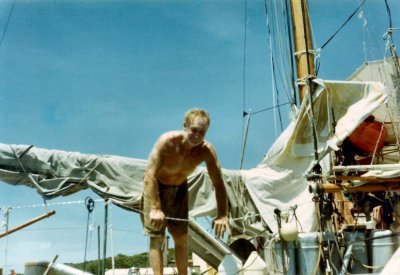 |
Before we sailed again we had a long
chat with the old schooner captain who’d saved us. The next
time we picked up our mooring line the jib was furled, the
main running free and the mizzen sheeted in hard, and the
whole maneuver was as smooth as silk - as everyone in the
anchorage can tell you. |
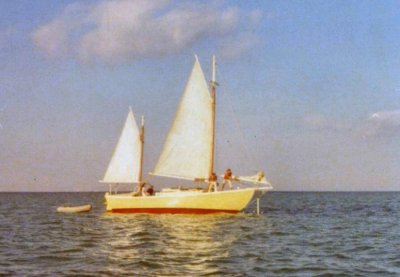 |
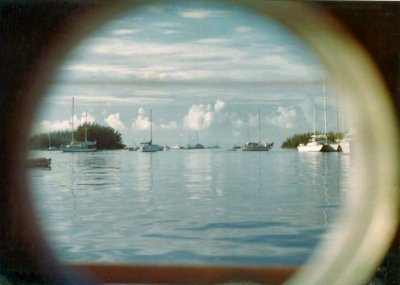 |
What We Did Right
-
We sailed
off the anchor/mooring smoothly that morning, although
luck probably played a part in that the first time.
-
We
practiced with the boat during that maiden sail, getting a
feeling for how she handled.
-
We managed
to maneuver Autant through the crowded anchorage without
snagging any of the myriad anchor lines, dinghy painters
and mooring floats.
-
We spared
the rigging a couple of harsh impacts by sheeting in the
mainsail ahead of each jibe.
-
We had the
sense to listen to the experienced schooner captain when
he loudly advised us to drop the jib.
-
Later, we
visited the old salt and talked at length with him about
ways to better handle an engineless gaff ketch. He
possessed a wealth of knowledge and shared it willingly.
We paid close attention and learned a lot.
What I Did Wrong
-
I hoisted
the jib before we cast off the mooring. Better to have
waited until the boat had fallen off.
-
I did not
decisively control which way Autant’s bow fell off when we
let go the mooring line that morning. Luckily it went the
right way, heading us out of the harbor rather than
farther into it. I soon learned to use the mizzen sail to
push her bow one way or the other when she’s in irons.
-
Although I
did practice rounding up out in the bay to see how the
boat carried, clearly I didn’t practice enough and I
underestimated her way when we approached the mooring.
-
I flew
into the anchorage under full sail in 15 knots of wind.
Bad idea! I got away with it, but it’s much smarter to
pass through a crowded harbor with minimum speed and
maximum control. On my ketch, the “jib & jigger” (jib &
mizzen) sail combination would’ve been just right,
de-powering the boat while maintaining good balance.
-
Obviously,
I had the boat moving too fast when I rounded up to the
mooring buoy. As a result, we had too much way on and
overshot the mark. Much better to have approached the
turning point more slowly or, barring that, to have headed
up from a point farther away from the buoy. Alternatively,
I could’ve (should’ve) let the boat carry past the mooring
ball and, when she finally came to a full stop, lowered
the bow anchor and eased her back to the mooring by
feeding out rode.
-
Last but
far from least, I failed to douse the jib when we rounded
up towards the mooring. The next time I knew better.
|
My years sailing a 40’ gaff-rigged ketch with no engine
provided a unique if sometimes humbling education. In time I
got pretty good at it, acquiring sailing and seamanship
skills that I might otherwise have missed in what has turned
out to be a lifetime at sea. This episode was only one
lesson in an endless succession. I’m still learning.
~ End ~ |
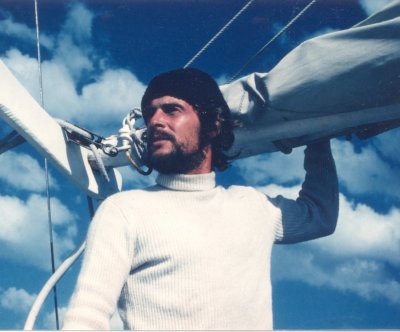 |
Back
to List of Tor's Tales